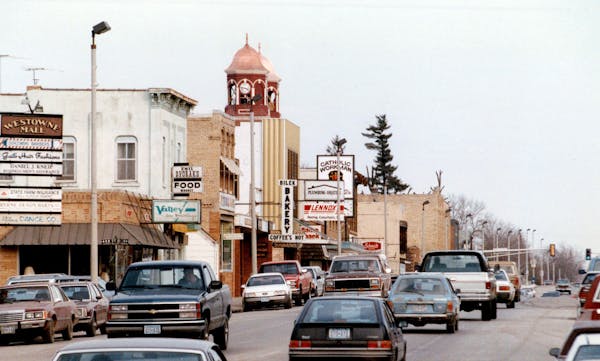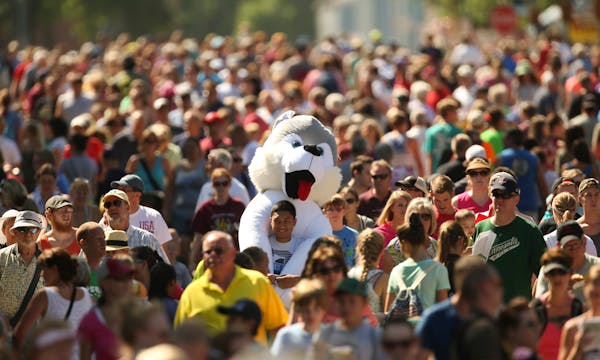Has Minnesota ever had a major earthquake?
Ward Voorhees was sitting on an outdoor bench during a coffee break one July morning when he felt the jolt, a loud rumbling in the ground that lasted just a few seconds.
Later that day, it was the talk of the town. The year was 1975, and an earthquake had struck the western Minnesota city of Morris.
Voorhees, who now serves as board president of the Stevens County Historical Society, said he didn't immediately realize what had happened.
"We don't expect earthquakes out here," he said.
More than four decades later, many Minnesotans are still surprised to learn about the Morris quake. Residents of the North Star State will persevere through the toughest blizzards, of course, and kids are drilled to take shelter away from windows during tornadoes. But earthquakes?
The Star Tribune looked into the state's seismic history for our Curious Minnesota project, a community-driven series of articles fueled by questions from readers. This week's submission asked: Are there earthquakes in Minnesota?
As longtime Morris residents like Voorhees know from experience, the answer is yes. Though Minnesota is one of the least seismically active states in the country, at least 20 earthquakes have jolted the state in the last 160 years, according to the Minnesota Geological Survey.
All were relatively minor. At an estimated 4.6 to 4.8 magnitude on the Richter scale, the 1975 Morris earthquake was the largest recorded with modern instruments in Minnesota. In contrast, the two earthquakes that rattled Southern California earlier this month — cracking buildings, causing fires and accompanied by a wave of aftershocks — were magnitudes 7.1 and 6.4, according to the Associated Press.
The destructive earthquakes making the headlines often happen when tectonic plates, massive pieces of the Earth's crust and upper mantle, grind together or slip past one another. The Pacific and North American plates, for instance, meet at California's San Andreas Fault, which stretches hundreds of miles and has triggered some of the country's largest tremors.
Minnesota doesn't lie on or near any plate boundaries. Earthquakes in the state could be a result of land rising after being depressed for centuries by sheets of glacial ice, said Paul Caruso, a geophysicist for the U.S. Geological Survey.
The process is called isostatic rebound. Caruso likened it to placing a rock on a sponge.
"You pull the rock off and gradually the sponge comes back to its old shape," he said. "The ice sheets were very heavy, and so they were pressing down on the earth. But since those ice sheets have melted, the earth is gradually springing back."
Val Chandler, a senior scientist at the Minnesota Geological Survey, wrote in a 2014 report that he thinks Minnesota earthquakes are likely caused by the slow westward drift of the North American plate, a movement that reactivates the state's ancient faults created during the formation of the continent.
The first earthquake recorded in Minnesota, which struck Long Prairie in central Minnesota in the early 1860s, is believed to be one of the largest in state history, with an estimated magnitude of 5. However, historical accounts — not modern technology — were used to assess that tremor. More recently, earthquakes recorded in 1994 and 2011 — in Granite Falls and Brandon, respectively — clocked in just above magnitude 3.
Other Midwestern states see more significant seismic action. The New Madrid Fault, which zigzags through parts of Missouri, Arkansas, Tennessee, Kentucky and Illinois, is capable of producing magnitude 8 earthquakes.
While Minnesota's rumblings are rare, they can still be frightening. Earthquakes that register above 2.5 can usually be felt, and those approaching a magnitude of 5 can cause structural damage, Caruso said. The Morris quake knocked dishes off shelves, cracked plaster and shook buildings, according to 1975 news reports.
But they're not something to stress about, either. Chandler said that while experts cannot say there is "zero probability" of a seriously damaging earthquake hitting Minnesota — and there's no reliable way to predict seismic activity — "the threat is very small compared to other natural hazards that have well-proven records of destruction, such as winter storms, tornadoes and flooding."
---
If you'd like to submit a Curious Minnesota question, fill out the form below:
Read more Curious Minnesota stories:
Why won't anyone in Minnesota take the last piece of food?
Is Minnesota's tiny Lake Itasca the true source of the Mississippi River?
How much are electric vehicles affected by Minnesota's extreme cold?
Why isn't Isle Royale a part of Minnesota?
Why is Uptown south of downtown in Minneapolis?
Why can't Minnesotans figure out how to zipper merge?
What percentage of Minnesotans spend their entire lives here?
How did Minnesota's indigenous people survive the extreme winters?


